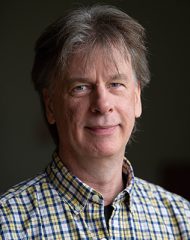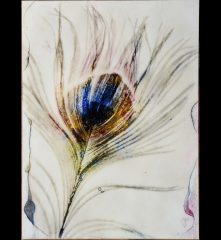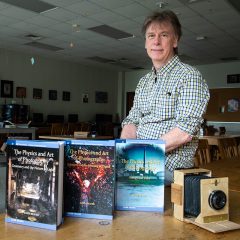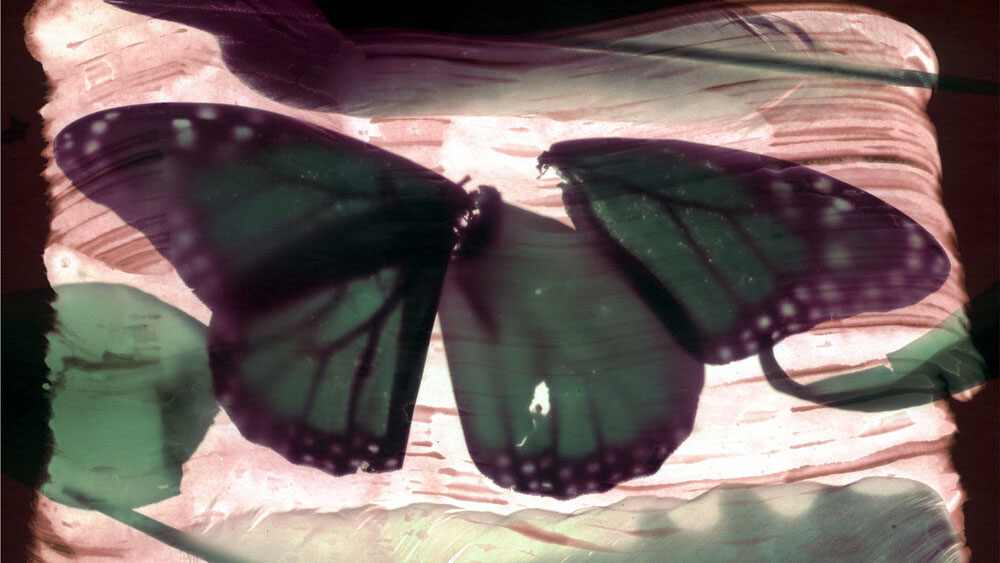A University of Wisconsin Oshkosh, Fox Cities campus physics and astronomy professor who has expertise in experimental photography, will travel to Barcelona, Spain, where he is an invited artist for the third annual Experimental Photography Festival July 20-24.

John Beaver
“The festival put out a call for artists late last year and I applied and was selected,” Beaver said. “We each had to propose three workshop sessions, along with submitted images and a proposal for a forum conference.”
Beaver, who has taught at the Fox Cities campus since 1998, said he “jumped at the chance” to apply—most of his photography over the past 20 years has been experimental and he’s always tried to develop new photographic processes, often using very old techniques but in new ways.
More than 300 international artists and photography lovers will meet with the aim of generating a common space to share, learn and discuss experimental photography in its many facets: from the creation of cameras, optics and films to printing processes, intervention, and production of copies, exhibitions and photobooks.
For the festival, Beaver will present two four-hour workshops on a set of techniques that he calls “ephemeral process photography” and “resinotype.”
Ephemeral is used for making negatives in a camera or for making non-permanent ephemeral prints. He does not desire complete control with his art.

“Peacock”
“I want my art to be partly controlled not consciously by myself, but by the world itself,” he said. “Perhaps some of this comes from the natural scientist in me.”
Resinotype is something unique—he doesn’t know of anyone who has done it before. It uses ultraviolet polymer resin—the kind, he said, that often is used in nail care salons. An acrylic epoxy is cured by ultraviolet light and is considered nontoxic.
Beaver said the resin is applied to a stiff board in a thin layer and it is then rolled smooth under a special type of transparent plastic sheet. Objects or photographic transparencies are placed on top, and it is exposed to sunlight or an ultraviolet lamp. Afterwards, the plastic is peeled off and pigments are dusted onto it. A full tone photographic image results.
Resinotype can be used with dark pigments on a white background to make a positive image or with light pigments on a dark background to make a negative image. Colored pigments also can be used.
Examples of his ephemeral process and resinotype photography will be on display from June 24 to Aug. 14 at Fox Cities campus’ Alyward Gallery.
Part of forum
While at the Barcelona festival, Beaver will participate with three others in a forum.
He said one topic he’ll discuss in Barcelona is the interplay between the image, the object and the process in art photography and how attention to physical interaction between light and the photographic medium can bring something new to photography—especially when using processes that are imperfect and only partially within control.
Author of multiple books

John Beaver and some of his books.
Beaver authored a three-volume The Physics and Art of Photography; and will soon release Photography: Physics and Art in Focus; and in 2023, LoFi Photography: Art from Do-It-Yourself Chemistry and Physics.
This spring, Beaver gave a talk at Ledgeview Nature Center on lunar and solar eclipses and what they can reveal about the nature of shadows and some of the earliest photographs ever made.
“In my art-science courses and books, I have mostly steered away from art that is about science as a subject,” he said. “Instead, I have tried to focus on how each can be a point of departure—an excuse really—for learning something serious about the other.”
He says he thinks that is why, long ago, he found himself most taken by photography with an experimental spirit to it.
Beaver thinks for that reason, he’ll fit right in at the experimental photo festival.
Learn more:

